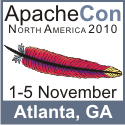ApacheCon North America 2010 will be held 1-5 November 2010, at the Westin Peachtree in Atlanta, Georgia, USA.
The official conference, trainings and expo of the Apache Software Foundation (ASF) will run to Atlanta this November, with dozens of sessions on Servers, Cloud Computing, Search NoSQL, Incubating projects, innovations, emerging technologies, and more.
ApacheCon would not be complete without a track dedicated to the project that started it all, the Apache HTTP Server. The Project Management Committee (PMC) are currently planning our own technical track for ApacheCon. We are solliciting 50-minute presentations for our conference track, to fill one day at the conference.
Topics of interest include:
- Case studies on deployment of the Apache HTTP Server within your organization
- How-to sessions on working with certain aspects of the Apache HTTP Server technology
- What’s New? sessions on new features of recent and upcoming versions of the Apache HTTP Server
- Sessions discussing third-party extensions to the Apache HTTP Server
- Security topics surrounding the Apache HTTP Server
- Performance and scalability of Apache HTTP Server deployment
- Cool things we all should know the Apache HTTP Server can do
- How you solved particularly gnarly problems deploying the Apache HTTP Server
Submissions are open to anyone with relevant expertise: ASF affiliation is not required to present at, attend, or otherwise participate in ApacheCon.
Please keep in mind that whilst we are encourage submissions that the highlight the use of specific Apache solutions, we are unable to accept marketing/commercially-oriented presentations.
All accepted speakers (not co-presenters) qualify for general conference admission and a minimum of two nights lodging at the conference hotel. Additional hotel nights and travel assistance are possible, depending on the number of presentations given and type of assistance needed.
To submit a presentation proposal, please edit the Wiki page and add your proposal, including:
- Your full name, title and organization
- Contact information, including your e-mail address. Feel free to obfuscate if you think that this will make a difference in your SPAM load
- The name of your proposed session (keep your title simple and relevant to the topic)
- A 75-200 word overview of your presentation
- A 100-200 word speaker bio that includes prior conference speaking or related experience
You will find an empty table template at the bottom of the page. Please copy this and fill it in.
Please mail any quesions regarding proposal submissions to pmc at httpd.apache.org.
To be considered, proposals must be received by Sunday, April 4nd, 2010, at 23:59:59 Pacific Time. Following this time, the PMC will hold a vote and suggest the most interesting proposals to the ApacheCon Planning Committee for acceptance to the conference. Note that the Apache HTTP Server PMC does not itself accept session proposals: it merely makes recommendations to the Planning Committee.
Key Dates:
April 4, 2010: Call for Participation closes
May 17, 2010: Speaker Acceptance/Rejection notification
November 1-5, 2010: ApacheCon NA 2010
We look forward to seeing you in Atlanta!


